AMD Frame Pacing Explored: Catalyst 13.8 Brings Consistency to Crossfire
by Ryan Smith on August 1, 2013 2:00 PM ESTHitman: Absolution
The second game in our lineup is Hitman: Absolution. The latest game in Square Enix’s stealth-action series, Hitman: Absolution is a DirectX 11 based title that though a bit heavy on the CPU, can give most GPUs a run for their money. Furthermore it has a built-in benchmark, which gives it a level of standardization that fewer and fewer benchmarks possess.
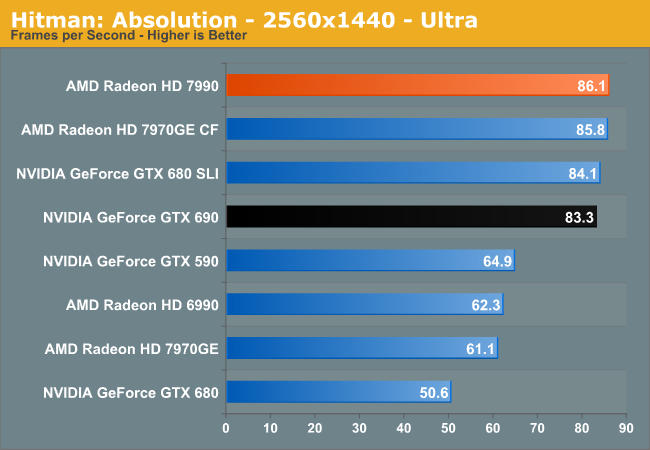
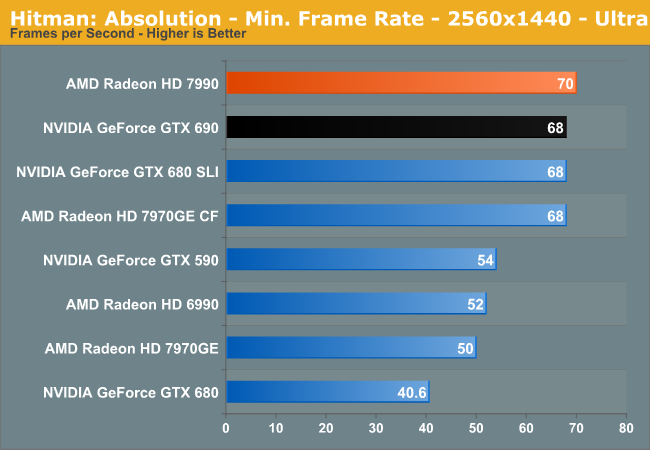
Again there’s nothing really new here. In the previous game the GTX 690 led, while in Hitman the 7990 leads.
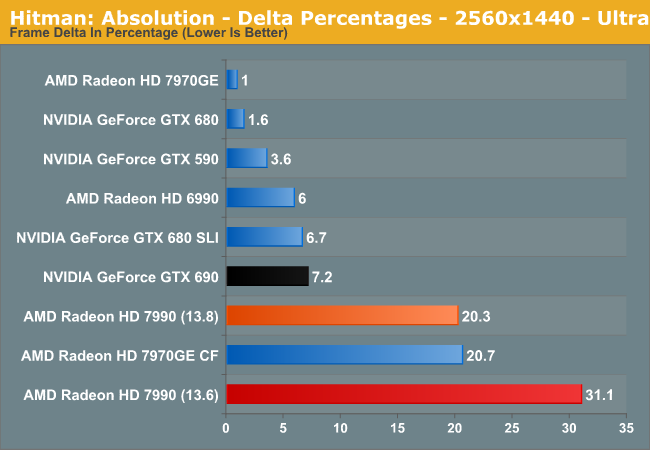
Moving on to our delta percentages, we again see the gains AMD has made with their frame pacing implementation, though Hitman was one of their better games in the first place. Consequently they’ve shaved off 11 percentage points, from 31 to 20, just enough to reach our 20% threshold but no more. This is still 13 percentage points worse than the GTX 690 however, so much like Shogun there’s still clear room for further improvement.
Meanwhile the FCAT graph data shows the same thing we saw with our numerical analysis, with the 7990 showing a much greater degree of variability. AMD’s frame pacing mechanism seems to be much less present here than in other games, with the adaptive window less noticeable here than elsewhere, perhaps due to the relatively high variability.
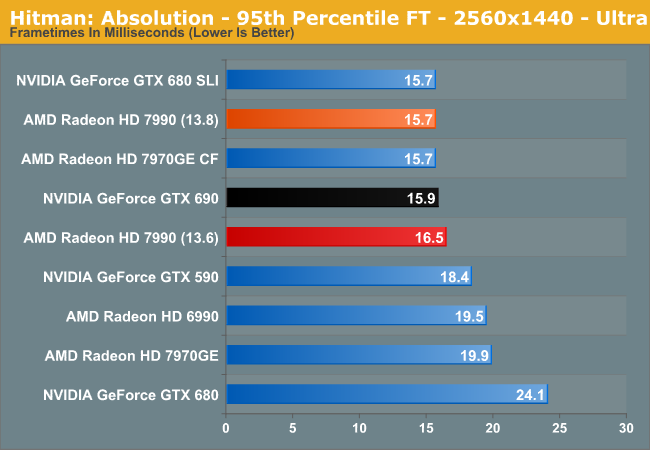
The smaller gains with regards to deltas are reflected in a much smaller improvement on 95th percentile times. Though in this case at the 95th percentile the 7990 is competitive with the GTX 690.


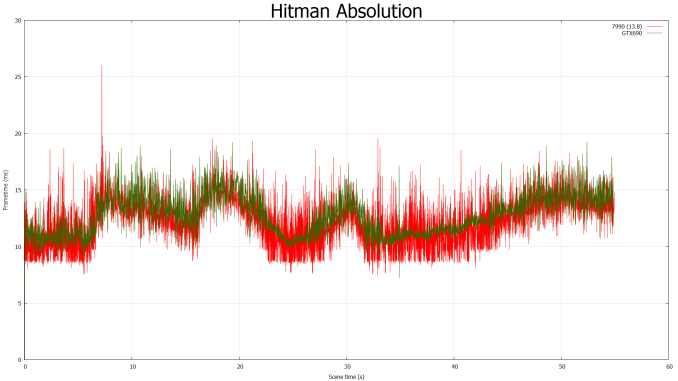








102 Comments
View All Comments
chizow - Wednesday, August 7, 2013 - link
There was discussions of microstutter on various forums associated with multi-GPU, but PCGH was the first site to publish it's findings in detail with both video evidence and hard data. From what I remember, they were the first to develop the methodology of using FRAPs frametimes and graphing the subsequent results to illustrate microstutter.BrightCandle - Friday, August 2, 2013 - link
One of the most shocking revelations to me is that AMDs quality assurance did not include checking the output of their cards frame by frame. I had always assumed that both NVidia and AMD had HDMI/DVI/VGA recorders that allowed them to capture the output of their cards so they could check them pixel by pixel, frame by frame and presumably check they were correct automatically.Such a technology would clearly have shown the problem immediately. I am stunned that these companies don't do that. Even FCAT is a blatantly blunt tool as it doesn't say anything about the contents of the frames. We still don't have any way to measure end to end latency for comparison either. All in all there is much to left to do and I am not confident that either company is testing these products well, its just I couldn't believe that AMD wasn't testing theirs for consistency (it was obvious when you played it something was wrong) at all.
krutou - Friday, August 2, 2013 - link
AMD is in the business of being the best performance per price entry in every market segment. Technology and quality come second.How often does AMD introduce and/or develop technologies for their graphics cards? The only two that come to mind are Eyefinity and TressFX (100 times more overhyped than PhysX).
Death666Angel - Saturday, August 3, 2013 - link
I think ATI had tessellation in their old DX8 chips. nVidia bought PhysX, so that shouldn't count. But I don't really see how having exclusive technology usable by a single GPU vendor is anything good. We need standardization and everybody having access to the same technologies (albeit with different performance deltas). Look at the gimmicky state of PhysX and imagine what it could be if nVidia would allow it to be fully utilized by CPUs and AMD GPUs?krutou - Saturday, August 3, 2013 - link
Because OpenCl and TressFX are doing so well right?bigboxes - Sunday, August 4, 2013 - link
March on, fanboi.JamesWoods - Sunday, August 4, 2013 - link
If you think that is all AMD/ATI has ever done for graphics then you sir, are ignorant. I was going to use a more degrading word there and thought better of it.Will Robinson - Friday, August 2, 2013 - link
LOL...what a load of tosh."NVDA had to take them by the hand"?
You and Wreckage ought to post in green text.
chizow - Friday, August 2, 2013 - link
Agree with pretty much of all of this, although I would direct a lot of the blame on AMD's most loyal, enthusiastic supporters as well. Every time microstutter was mentioned and identified as being worst with AMD solutions, AMD's biggest fans would get hyperdefensive about it. If those most likely to have a problem were too busy denying any problem existed, it really should be no surprise it was never fixed.And this is the result. Years of denial and broken CF, finally fixed as a result of the scrutiny from the press and laughter of Nvidia fans which brought this to a head and forced AMD to take a closer look and formulate a solution.
EJS1980 - Friday, August 2, 2013 - link
"Truth favors not one side."